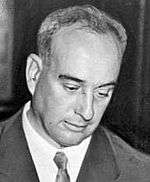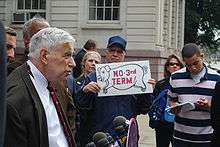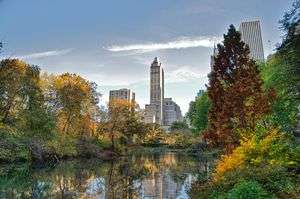New York City Department of Parks and Recreation
 | |
 Flag of the Parks Department | |
| Department overview | |
|---|---|
| Formed | 1910 |
| Preceding department |
|
| Jurisdiction | New York City |
| Headquarters |
Arsenal New York, NY 10065 |
| Department executive |
|
| Key document | |
| Website |
www |
The New York City Department of Parks and Recreation, also called Parks Department and NYC Parks, is the department of the government of New York City[2] responsible for maintaining the city's parks system, preserving and maintaining the ecological diversity of the city's natural areas, and furnishing recreational opportunities for city's residents and visitors.
The total area of the properties maintained by the department is over 30,000 acres (120 km2).[3]
The department maintains more than 1,700 parks, playgrounds and recreation facilities across the five boroughs. It is responsible for over 1,000 playgrounds, 800 playing fields, 550 tennis courts, 35 major recreation centers, 66 pools, 14 miles (23 km) of beaches, and 13 golf courses, as well as seven nature centers, six ice skating rinks, over 2000 greenstreets and four major stadiums. Parks also cares for park flora and fauna, community gardens, 23 historic houses, over 1,200 statues and monuments, and more than 2.5 million trees.[4]
The City of New York Department of Parks & Recreation produces many special events, including concerts and movie premieres. In the summer, the busiest season, the agency organizes free carnivals and concerts, and sends mobile recreation vans to travel throughout the five boroughs providing free rental equipment for skating, baseball, and miniature golf.
The largest single component of parkland maintained by the department is the "forever wild" Pelham Bay Park in the Bronx, with an area of 2,765 acres (11.19 km2).[4] The department is also responsible for such "flagship" parks facilities as Central Park, Pelham Bay Park, Prospect Park, Van Cortlandt Park, Flushing Meadows Corona Park, and the Staten Island Greenbelt, though many of these parks are maintained by private, non-profit conservancies.
The symbol of the department is a cross between the leaf of the London plane and a maple leaf. It is prominently featured on signs and buildings in public parks across the city. The London plane tree is on the NYC Parks Department's list of restricted use species for street tree planting because it constitutes more than 10% of all street trees.
Agency
The department is a mayoral agency. The current Parks Commissioner is Mitchell Silver. The current chair of the New York City Council Committee on Parks & Recreation is Barry Grodenchik.[5]
The department is allocated an expense budget and a capital budget. The expense budget covers the total expenses incurred by the agency, including salaries. The capital budget is dedicated solely for new construction projects, as well as major repairs in parks that have a useful life of more than five years and cost at least $35,000.
Its regulations are compiled in Title 56 of the New York City Rules.[6]
History
The original Parks Commission was formed in 1856 and was responsible only for Central Park. In 1870 the Tweed Charter gave it jurisdiction for all the parks in Manhattan. In addition each borough had its independent Park Commission. A unified city-wide New York City Parks Department was formed in 1934 with Robert Moses as the commissioner, a position he held until 1960. In 1968 it was reorganized as the "Parks, Recreation & Cultural Affairs Administration. In 1976 it was given its current name.[7]
Organization
- Commissioner of the Department of Parks and Recreation
- Assistant Commissioner for Agency Compliance
- General Counsel
- Parks Advocate (Internal Investigative Officer)
- Assistant Commissioner for Communications
- Assistant Commissioner for Equal Employment Opportunity
- Inspector General
- First Deputy Commissioner
- Deputy Commissioner/Chief Operating Officer
- Assistant Commissioner for Citywide Operations
- Assistant Commissioner for Forestry, Horticulture, and Natural Resources
- Deputy Commissioner/Chief Operating Officer
- Deputy Commissioner for Capital Projects
- Deputy Commissioner, Urban Park Service, and Public Programs
- Assistant Commissioner for Public Programs
- Assistant Commissioner for Urban Park Service
- Deputy Commissioner for Administration/Chief Administrative Officer
- Assistant Commissioner for Budget and Fiscal Management
- Assistant Commissioner for Innovation and Performance Management
- Deputy Commissioner of Planning and Development
- Borough Commissioners
- Bronx Parks Commissioner
- Brooklyn Parks Commissioner
- Manhattan Parks Commissioner
- Queens Parks Commissioner
- Staten Island Parks Commissioner
Park law enforcement
The department maintains an enforcement division, called the Parks Enforcement Patrol (PEP), responsible for maintaining safety and security within the parks system. Parks Enforcement Patrol officers have peace officer status under NYS Penal Law and are empowered through this status to make arrests and issue tickets. PEP officers patrol land, waterways and buildings under the jurisdiction of the Department of Parks and Recreation on foot, bicycle, horseback, boat and marked patrol trucks. PEP officers are also responsible for physical site inspections of NYC park concession facilities to assure the concessionaires compliance with state laws.[8]
Urban Park Rangers
The Urban Park Rangers was founded as a pilot program in 1979 by then Parks Commissioner Gordon J. Davis, with the support and encouragement of Mayor Ed Koch. The program provides many free programs year-round, such as nature walks and activities. They also operate programs such as The Natural Classroom for class trips and the general public alike. "Explorer" programs are available for activities such as canoeing in the city's flagship parks in all five boroughs. NYC Urban Park Rangers are easily identified by their uniforms.[9]
Although NYC Park Rangers possess peace officer status, their primary mission is environmental education, protection of park resources, and visitor safety. Law enforcement in city parks is the responsibility of the New York City Police Department.
Community Parks Initiative
The Community Parks Initiative was launched in 2014 and is providing $318 million dollars of capital funding to improve more than 60 parks mainly located in densely populated neighborhoods where there are significant rates of poverty. The park improvements, such as Ranaqua Park in the South Bronx, consist of playground equipment, lighting, seating areas, water fountains, synthetic turn fields, trees and greenery, and rain gardens to collect storm water.[10][11] The Longfellow Park renovation, also in the Bronx, is budgeted at $3.25 million and includes tree houses for children, bike racks, a sprinkler system for summer recreation, and a mini-state.[12]
Public-private partnerships
The New York City Department of Parks and Recreations maintains facilities and provides services through a network of public service workers, volunteers, and partnerships with private organizations.
The momentum for private partnerships increased dramatically during the mayoralty of Michael Bloomberg. Often the initiatives of Parks Commissioner Adrian Benepe were controversial.[13]
Concessions
Most businesses that operate or generate revenue on New York City parkland are considered concessions and must obtain a permit or license from the Revenue Division of Parks. Pursuant to the City's Concession Rules, these licenses and permits are generally awarded through a public solicitation process, such as a Request for Bids (RFB) or Request for Proposals (RFP).[14]
Approximately 500 concessions currently operate in parks throughout the five boroughs, and they generally fall into two categories: food service and recreation. The food service concessions range from pushcarts selling hot dogs to restaurants such as Tavern on the Green and Terrace on the Park. Recreational concessions include facilities such as ice rinks, stables, marinas, and golf courses. In fiscal year 2009, the Revenue Division of the Parks Department helped collect over $110 million in revenue from various sources including concessions, lease agreements, like those for Citi Field and Yankee Stadium, special events, and dockage.[15]
Private Partnerships
At the turn of the 20th century most of the staffing of New York City parks were patronage jobs. In the 1950s and 1960s, public sector unions organized most park workers which was considered at the time the first major political defeat of Robert Moses. During the city's fiscal crisis in the 1970s, the Department of Parks and Recreation City adapted practices such as using welfare recipients and volunteers to do work previously completed by unionized workers and to forge partnerships with nonprofit organizations and local sports league. Yorkville Sports (YSA) was one of those that helped maintain athletic fields prior to use and assumed responsibilities previously handled by the public sector. During this time the Central Park Conservancy and the Prospect Park Alliance were formed.[16]
Wright vs. Stern
In 2001, the department underwent an investigation after the U.S Attorney's Office received complaints from employees that they had suffered employment discrimination. The lawsuit alleged that the Parks Department violated the Civil Rights Act of 1964 by engaging in a pattern or practice of discrimination against employees on the basis of their race and/or national origin in making promotion decisions. According to the Complaint, the Parks Department's senior managers sought out and promoted whites to management positions without announcing job openings for those positions or conducting any formal interview process, all in plain disregard of the Parks Department's own stated equal employment opportunity policies. From at least 1995, minorities have been significantly under-represented in the Parks Department's managerial ranks according to the Complaint. The judge had ruled that the plaintiffs had presented substantial evidence to merit a trial on the allegations of class-wide discrimination in pay, promotions and retaliation. In 2008, the City of New York agreed to pay $21 million to settle the federal class action lawsuit. By agreeing to settle the claims, the City avoided a trial on the allegations.[17]
List of Park Commissioners
Since 1934, when New York City Parks Department Commissioners were unified, the directors have been:[18]
| Portrait | Named individual | Start date | End date | Tenure | Mayor(s) served under |
|---|---|---|---|---|---|
 | Robert Moses | January 18, 1934 | May 23, 1960 | 26 years, 4 months | Fiorello H. La Guardia William O'Dwyer Vincent R. Impellitteri Robert F. Wagner Jr. |
| Newbold Morris | May 24, 1960 | January 15, 1966 | 5 years, 8 months | Robert F. Wagner Jr. | |
 | Thomas Hoving | January 16, 1966 | March 15, 1967 | 1 year, 3 months | John V. Lindsay |
| August Heckscher | March 16, 1967 | December 31, 1972 | 5 years, 9 months | John V. Lindsay | |
| Richard M. Clurman | January 1, 1973 | December 31, 1973 | 1 year | John V. Lindsay | |
| Edwin L. Weisl, Jr. | January 1, 1974 | September 22, 1975 | 1 year, 9 months | Abraham Beame | |
| Alexander Wirin | September 23, 1975 | December 28, 1975 | 3 months | Abraham Beame | |
| Martin Lang | January 1, 1976 | June 30, 1977 | 1 year, 6 months | Abraham Beame | |
| Joseph P. Davidson | July 2, 1977 | January 20, 1978 | 6 months | Abraham Beame | |
 | Gordon J. Davis | January 23, 1978 | April 1, 1983 | 5 years, 3 months | Ed Koch |
 | Henry J. Stern | April 2, 1983 | February 4, 1990 | 6 years, 10 months | Ed Koch |
| Elisabeth F. Gotbaum | February 5, 1990 | December 31, 1993 | 3 years, 11 months | David Dinkins | |
 | Henry J. Stern | January 1, 1994 | February 3, 2002 | 8 years, 1 month | Rudolph Giuliani |
 | Adrian Benepe | February 4, 2002 | August 29, 2012 | 10 years, 6 months | Michael Bloomberg |
| Veronica M. White | August 30, 2012 | December 31, 2013 | 1 year, 4 months | Michael Bloomberg | |
| Liam Kavanagh | January 1, 2014 | May 12, 2014 | 5 months (Acting) | Bill de Blasio | |
| Mitchell Silver | May 12, 2014 | Incumbent | Bill de Blasio | ||
See also
- New York City Office of Administrative Trials and Hearings (OATH), for hearings conducted on summonses for quality of life violations issued by the Department
- List of New York City parks
- List of privately owned public spaces in New York City
- New York State Office of Parks, Recreation and Historic Preservation
References
- ↑ Foderaro, Lisa (March 20, 2014). "North Carolina Planner Named to Head New York City Parks Dept". NYTimes. Retrieved March 22, 2014.
- ↑ New York City Charter § 531; "There shall be a department of parks and recreation the head of which shall be the commissioner of parks and recreation."
- ↑ "About Parks : NYC Parks". www.nycgovparks.org. Retrieved January 20, 2016.
- 1 2 "Frequently Asked Questions : NYC Parks". www.nycgovparks.org. Retrieved January 20, 2016.
- ↑ https://council.nyc.gov/committees/parks-and-recreation/
- ↑ "Rules & Regulations : NYC Parks". www.nycgovparks.org. Retrieved January 20, 2016.
- ↑ https://www.nycgovparks.org/about/history/commissioners
- ↑ "Park Enforcement Patrol : NYC Parks". www.nycgovparks.org. Retrieved January 20, 2016.
- ↑ "Urban Park Rangers : NYC Parks". www.nycgovparks.org. Retrieved January 20, 2016.
- ↑ https://www.nycgovparks.org/about/framework-for-an-equitable-future/community-parks-initiative
- ↑ Mitchell, Alex (May 4–10, 2018). "Ranaqua Park reopens after major renovations". Bronx Times Reporter. p. 14.
- ↑ Valenzuela, Sarah (May 4, 2018). "Kids break ground on Longfellow Park restoration". Bronx Times Reporter. p. 20.
- ↑ Swan, Cathryn (July 19, 2013). "Pushing Privatized "Partnership" Agenda at New York City's Public Parks — Part 3". Huffington Post Blog.
- ↑ "Concessions Opportunities : NYC Parks". www.nycgovparks.org. Retrieved January 20, 2016.
- ↑ "Concessions : NYC Parks". www.nycgovparks.org. Retrieved January 20, 2016.
- ↑ Krinsky, John; Simonet, Maud. Who cleans the park? : public work and urban governance in New York City. Chicago. p. 5. ISBN 9780226435619. OCLC 979417574.
- ↑ "Wright v. Stern: NYC Parks Case | NAACP LDF". www.naacpldf.org. Retrieved January 20, 2016.
- ↑ "New York City Parks Commissioners : NYC Parks". www.nycgovparks.org. New York City Department of Parks and Recreation. Retrieved September 29, 2017.
External links
- City of New York Department of Parks & Recreation official site
- Urban Park Rangers
- Parks History
- Interactive Park Map of New York City
- Department of Parks and Recreation in the Rules of the City of New York
Coordinates: 40°46′3.5″N 73°58′16.7″W / 40.767639°N 73.971306°W


.jpg)